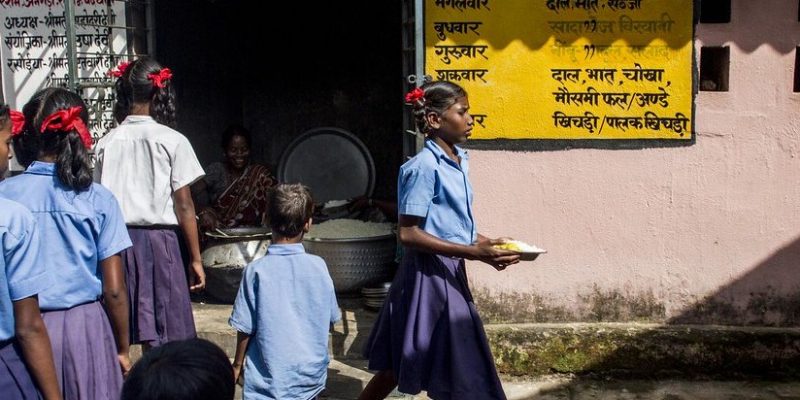Before the nationwide lockdown to contain the spread of the novel coronavirus, Hemant Soren’s government in Jharkhand had announced a review of the earlier government’s school merger project.
In line with the promises of both the Jharkhand Mukti Morcha (JMM) and the Congress before the state elections in 2019, the school education and literacy minister, Jagarnath Mahto, had said that the process of reopening schools that had been closed as part of the school reorganisation plan would begin after the review.
Now that the lockdown is being relaxed and there has been a decision to reopen schools in July, the Jharkhand government must prioritise reopening schools which were closed in the name of reorganisation or mergers. A policy review must be initiated immediately and arrangements made accordingly.
The back story
In consonance with the NITI (National Institution for Transforming India) Aayog, the then Jharkhand government had announced its SATH-E (Sustainable Action for Transforming Human Capital – Education) project in 2017, which aimed to reorganise the school system in the state by merging small schools with bigger schools nearby. This, the then government said, was to improve the quality of education, meet teacher requirements and allocate resources efficiently. The project was to be carried out in consultation with Boston Consultancy Group, a private multinational company.
Based on recommendations from this firm, between December 2017 and September 2018, the state’s Department of School Education and Literacy closed 4,600 small-scale schools. According to the nodal officer of the SATH-E project, all the schools in the state had been tagged by GPS in 2016-17, primarily to learn two things: 1) the distance between two schools, and 2) the number of students on each school’s rolls.
Also read: In Jharkhand’s Khunti, Children Lose Out as Schools Become Security Camps
The consultancy firm believed 20,000 small schools in Jharkhand should be merged with other schools. This was to be done in two phases. In the first phase, mergers of 6,500 schools were proposed, of which the actual mergers were 4,600. In the second phase – which was stalled due to stiff resistance from the public – the firm proposed the merger of 15,000 more schools. The bigger schools in any area were to be the host schools and the smaller schools were to be merged into the hosts. The responsibility to enrol students from the closed schools to the host school lay with the government.
The then government argued that small scale schools have several structural disadvantages in delivering quality education and that the mergers would improve efficiency. The implementation of the project would also mean huge public expenditure savings since there would be fewer schools and resources could be better allocated. The then government argued that with adequate arrangements for transportation and other support mechanisms, fewer but bigger schools would lead to a marked difference in the quality of education.
Similar arguments had been made in other states and school mergers had taken place on a large scale in Maharashtra, Rajasthan, Telangana, Orissa and elsewhere. But the plan did not appear to work. Professor Srinivas Rao and others from Jawaharlal Nehru University released a research report in 2017 that showed how school mergers had led to an increase in dropout rates and a decline in female literacy. Their study also showed that the physical presence of the school building was a big motivation for parents to send their children to school.
In Jharkhand, the policy of school mergers met with severe resistance from politicians, including 12 BJP Lok Sabha MPs from the state, social activists, civil society organisations and others. Those resisting pointed out that ignorance and a disregard for the voices of the people – parents, teachers, gram sabha and the schools’ principals – lay at the core of the policy. It ignored the impact it would make on the rural areas of Jharkhand, a state with rugged topography, and especially among Adivasi children and women. The policy fundamentally viewed schools as mere numbers, not as social and cultural sites of interaction and learning amongst various members of society.

A page from the document prepared by the consultancy firm. Photo: Author provided
A tale of two schools
In Manika, Latehar, a primary school was merged with a high school in Bandua village – one of the largest villages in the block. The high school, with classes I to X and a pre-primary section, has 10 rooms of which only four are usable because the roofs in the other six rooms are weak. Teachers at the school said the roofs could collapse at any time and have thus clubbed 10 classes into four rooms.
Though there are separate toilets for boys and girls, the building has no water supply or electricity connection. Evidently, the merger of schools did not lead to significant changes in the infrastructure and other facilities of the host school. Instead, it has created more problems for the students who now have to travel farther.

The classroom of the high school in Manika. Photo: Author provided
The distance between the two schools is more than 1.5 km on uneven kachha roads running between isolated stretches of farmland. In Latehar, the principal of the closed school was supposed to enrol his former students in the new host school, but did not do so. As a result, only 15 students joined the school after the merger. Most of these 15 children do not go to the school at all because of the increase in distance. On the day a member of my fieldwork team visited the school, not one of these 15 children was there.
Later, a group of children in a nearby hamlet told my team member that some of them go to another government school that is closer to their homes than the high school in Bandua, some are enrolled in private schools that recently opened in the area where the primary school was closed and several girls said they had dropped out.
Aged between 11 and 14, these young women dropped out of school because it was too far for them to walk. To get to the high school in Bandua, they would need to walk for over an hour every day and thus be unable to help with household work. As a result, most of the parents have taken the girls out of school. One of these girls asked rhetorically, “Ghar dekhe ki padhai kare (Should I study or look after the house)?”
Also read: Is Social Distancing Feasible for a Majority of Schools in India?
Where the family can afford to send only one child to the nearby private school, the son is enrolled while the girl stays home. Clearly the school merger policy completely ignores the impact of the increase in distance on the education of girls.
In another instance in Manika, a primary school was merged into another primary school in an adjoining village. The distance between the two schools is about 1.5 km via kachha roads. The principal of this closed school, unlike the principal of the school mentioned above, worked hard to enrol his former students in the host school, sometimes even talking to parents to ensure that the children continued their education.
While this principal’s actions spoke well for his sense of responsibility, it also showed that this mechanism leaves the enrollment of students at host schools at the discretion of the principal without any checks and balances –a responsible principal may make the effort to enrol the students, but another one leaves the students to fend for themselves.
But even a responsible principal cannot ensure that small children who are to be enrolled in schools for the first time get access to distant schools.

The host school in the Chama village. Photo: Author provided
The ground realities
The closed primary school had a pre-primary section which was closed one year ago. The village has no anganwadi. Earlier, the smaller children would go to school to learn and play but now, due to the closure of the school, several families who would like to send the younger children to school are too scared to do so because of the risks involved. They fear intimidation and violence by the older children, children losing their way to school, wandering around without supervision and so on. One of the parents exclaimed: “Chote se nahi sawaarenege, toh padhe gali khega nahi – siksha vanchitreh jayge. (If they do not learn as children, they will never study – they will be educationally deprived).”
In both the cases described above, people said that no consultation was held either with the gram sabha or the school management committees before the mergers took place. Instead, they were informed of the mergers only when a letter, addressed to the school principal, arrived. The principals and teachers of the schools were also not consulted.
At the core of this whole process is the arrogance of the state towards marginalised people – the people who would be most affected by the mergers were not consulted at any stage. This is despite the fact that Jharkhand is a 5th schedule area with a majority population of adivasis. This shows how the underprivileged are systematically silenced by the system. One of the villagers in Manika said, “Jab school khulne ke pehle survey hua tha, toh band hone ke pehle kyu nahi hua (If there was a survey before the school opened, why wasn’t there one before it closed)?”
In Khunti, the state department of education said that the first round of mergers took place in 2016 when district officers identified and closed 16 schools which were apparently substandard and did not meet the norms laid down in the Right to Education Act, 2009. After recommendations by the consultancy firm, 175 schools in Khunti were closed.
Also read: Here’s How We Can Gear up to Open Schools After the Lockdown
In one instance, two schools were merged into a middle school functioning alongside a CRPF camp in Khunti’s Arki block. After this merger, only about 15 students from one of the closed schools enrolled at the middle school, while no one from the other school enrolled at all. On the day my fieldwork team member visited, a gram sabha was held and villagers said that there had been over 300 students in the school earlier, but the number reduced to approximately 120 (cross-verified in the U-DISE data on enrollment) after the security camp was established. It is thus important to ask how this school, functioning alongside a CRPF camp and showing a continuous fall in enrollment rates, was chosen as the host for two other schools. The villagers said they had neither been consulted nor informed about the schools closing or the merger.

The middle school in Khunti functioning alongside a CRPF camp. Two schools were merged in this school. Photo: Author provided
Small is healthier
The policy of school mergers is fraught with multiple challenges, especially when implemented with a top down approach. This approach to education is fundamentally exclusionary in nature, eliminating marginalised children from the education system. This was emphasised by a 14-year-old girl who asked, “Agar duniya mein sirf ek school hota, toh kya sabhi log padh pate (If the world had only one school, could everybody study)?”
Apart from ignoring the local contexts and disregarding the voices of the people, the policy fundamentally manifests the withdrawal of the government from educational spaces and encourages private players to enter these vacant spots. As a result, parents are often forced to pay for private schooling which is an additional burden on poor families.
With our new emphasis on ‘learn to live with COVID,’ we must shift our focus back to neighbourhood schools which are easily accessible for children. Nearby schools would imply less travel and less exposure to health risks. Along with this, as migrant workers from various states return to their villages, it is likely that the number of children to be enrolled in schools will increase. With the reopening of closed schools, it must be ensured that these children are admitted into the schools. While the schools should have been reopened anyway (after due consultation with the people and gram sabhas), the relaxation of the lockdown requires it to be prioritised.
The current crisis has exposed severe loopholes in the country’s public health system and we cannot wait for another crisis before realising the importance of public education. It must be remembered that the Right to Education is a fundamental right under Article 21A of the constitution, which shows some political commitment towards the universalisation of education. The reorganisation of schools raised several doubts about the government’s approach to universalisation. The withdrawal of the government from educational spaces has to be duly redressed for a comprehensive and robust education system.
Varsha Poddar is doing an M.Phil. in the Sociology of Education at TISS, Mumbai. This article contains inputs from Sabhil, Mahadev and Etwa.




